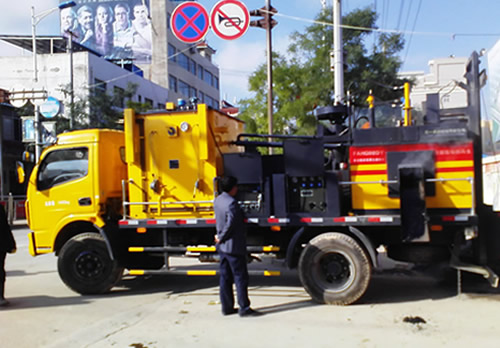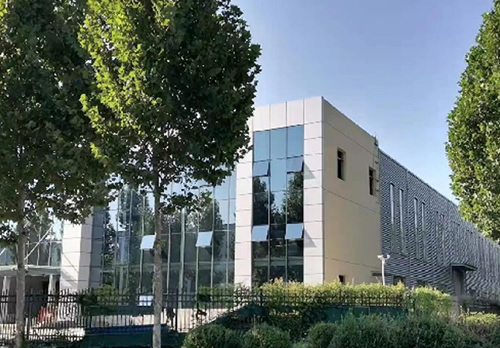In modern transportation networks, asphalt pavement has become the main choice for road construction due to its good smoothness, skid resistance, and driving comfort. However, with the continuous increase of vehicle loads and the continuous erosion of the natural environment, various diseases such as cracks, potholes, ruts, etc. will inevitably appear on asphalt pavements. These diseases not only affect driving safety and comfort, but also shorten the service life of the road surface. Therefore, timely and efficient daily maintenance and repair of asphalt pavement is crucial. Asphalt pavement repair vehicles, as a professional road maintenance equipment, play a key role in this process.
2、 Asphalt pavement diseases and their impacts
(1) Common types of diseases
Cracks: including transverse cracks, longitudinal cracks, and mesh cracks. Horizontal cracks are mainly caused by thermal expansion and contraction due to temperature changes, resulting in horizontal cracking of the road surface; Longitudinal cracks are usually related to uneven settlement of the roadbed and improper treatment of construction joints; Mesh cracks are a manifestation of aging and fatigue in road surface materials, often caused by the combined effects of repeated vehicle rolling and environmental factors.
Pit groove: Pit groove is one of the common diseases of asphalt pavement, which is often formed by the looseness and peeling of pavement materials. The intrusion of rainwater, friction and impact of vehicle tires will gradually cause the road surface material to lose its adhesive strength, forming local depressions, namely potholes.
Rutting: Rutting is a permanent deformation of the road surface caused by the repeated action of vehicle loads, commonly found in heavy-duty traffic sections and bends. Ruts can affect the drainage performance of the road surface, causing water accumulation in rainy weather, increasing the risk of vehicle slippage, and also reducing driving comfort.
(2) The impact of diseases
The existence of asphalt pavement diseases can have a serious impact on driving safety and road service life. Cracks and potholes can cause bumps in the vehicle during driving, increase wear on vehicle components, and even lead to safety accidents such as tire blowouts and vehicle loss of control. Rutting can affect the vehicle's trajectory and increase the difficulty for drivers to operate, especially at high speeds where the danger is greater. In addition, the development of diseases will accelerate the damage of the road surface, shorten the service life of the road surface, and increase the maintenance cost of the road.
3、 Working principle and types of asphalt pavement repair vehicles
(1) Working principle
The asphalt pavement repair vehicle mainly consists of heating system, mixing system, conveying system, and compaction system. Its working principle is to first heat the asphalt material to the appropriate construction temperature through a heating system, so that it has good fluidity and adhesion. Then, in the mixing system, the heated asphalt is thoroughly mixed with aggregates, additives, etc. to form a uniform mixture. Next, the mixture is transported to the location of the road surface that needs to be repaired using a conveying system. Finally, the repaired area is compacted using a compaction system to tightly bond with the original road surface, achieving the purpose of repair.
(2) Common types
Heating type repair vehicle: This type of repair vehicle mainly heats the old road surface material through a heating device, softens it, and mixes it with newly added asphalt mixture to achieve road surface repair. Heating type repair vehicles are suitable for repairing small areas of road surface diseases, with the advantages of fast construction speed and high utilization of raw road materials.
Mixing type repair truck: The mixing type repair truck is equipped with a specialized mixing device, which can mix various raw materials in a certain proportion to produce asphalt mixture that meets the requirements. This type of repair vehicle is suitable for large-scale road surface repairs and local repairs of newly built roads, and has the characteristics of stable mixture quality and high construction efficiency.
Comprehensive repair vehicle: The comprehensive repair vehicle combines the advantages of heating and mixing repair vehicles, which can both heat and regenerate old road materials and mix new mixtures. It has powerful functions and a wide range of applications, which can meet the repair needs of different types of road surface diseases.
4、 Application of Asphalt Pavement Repair Vehicles in Daily Maintenance
(1) Preventive maintenance
Preventive maintenance is a maintenance measure taken before obvious road diseases appear, aimed at delaying the development of road diseases and extending the service life of the road surface. Asphalt pavement repair vehicles can be used for sealing treatment of road surfaces, such as micro surfacing and slurry sealing. By evenly spraying the mixed sealing material onto the road surface, a protective film can be formed to prevent erosion by rainwater, ultraviolet rays, etc., while improving the anti-skid performance of the road surface.
(2) Disease repair
When cracks, potholes, and other defects appear on the road surface, asphalt pavement repair vehicles can quickly arrive at the site for repair. For cracks, the repair vehicle can first clean the cracks, then inject heated sealant to fill the cracks and prevent rainwater from seeping in. For potholes, the repair vehicle can fill the heated and mixed asphalt mixture into the pothole and compact it with a compaction system to quickly repair the pothole.
5、 The advantages of asphalt pavement repair vehicles
(1) Efficiency
Asphalt pavement repair vehicles have the characteristics of speed and efficiency. It can complete the repair of road surface diseases in a short period of time, greatly reducing the construction time and minimizing the impact on traffic. For example, traditional manual repair methods may take hours or even days to complete, while using asphalt pavement repair vehicles only takes tens of minutes to several hours to complete.
(2) Strong maneuverability
The repair vehicle can flexibly move to different locations of road surface defects for operation, without being limited by road conditions and geographical location. Whether it is urban roads, highways, or rural roads, asphalt pavement repair vehicles can be conveniently used for construction.
(3) High construction quality
The asphalt pavement repair vehicle can ensure good bonding between the repair material and the original pavement through precise heating, mixing, and compaction control, and improve the durability and strength of the repair area. At the same time, the repaired road surface has high smoothness, which can effectively improve driving comfort.
(4) Environmental protection and energy conservation
Modern asphalt pavement repair vehicles adopt advanced heating technology and energy-saving equipment, which can reduce energy consumption and exhaust emissions. For example, some repair vehicles use microwave heating technology, which is more energy-efficient and environmentally friendly compared to traditional open flame heating methods.
6、 Maintenance and Management of Asphalt Pavement Repair Vehicles
(1) Regular maintenance
In order to ensure the normal operation and service life of asphalt pavement repair vehicles, regular maintenance and upkeep are necessary. Regularly inspect the working status of key components such as the engine, hydraulic system, and heating system of the vehicle, and replace worn parts in a timely manner. At the same time, clean the mixing tank, conveying pipeline, etc. of the vehicle to prevent the residue and agglomeration of asphalt materials.
(2) Operator training
The professional skills and operational level of operators directly affect the effectiveness and construction quality of asphalt pavement repair vehicles. Therefore, it is necessary to provide professional training for operators to familiarize them with the performance, operation methods, and safety precautions of vehicles. Operators should strictly follow the operating procedures to ensure the safety and quality of the construction process.
(3) Equipment management
Establish a comprehensive equipment management system and keep detailed records of the use, maintenance, and upkeep of asphalt pavement repair vehicles. Reasonably arrange the operation plan of vehicles and improve the utilization rate of equipment. At the same time, ensure proper storage and preservation of equipment to prevent damage and corrosion.
7、 Case analysis
Taking road maintenance in a certain city as an example, before the introduction of asphalt pavement repair vehicles, the repair of road diseases in the city mainly relied on manual methods, with low construction efficiency, difficult quality assurance, and significant impact on traffic. After the introduction of asphalt pavement repair vehicles, the repair speed of road diseases has significantly accelerated, and the construction quality has been significantly improved. For example, on a main road, the pit repair work that used to take a month to complete can now be completed in just one week using asphalt pavement repair vehicles, greatly reducing the impact on traffic. At the same time, the repaired road surface has greatly improved in terms of smoothness and durability, receiving widespread praise from citizens.
2、 Asphalt pavement diseases and their impacts
(1) Common types of diseases
Cracks: including transverse cracks, longitudinal cracks, and mesh cracks. Horizontal cracks are mainly caused by thermal expansion and contraction due to temperature changes, resulting in horizontal cracking of the road surface; Longitudinal cracks are usually related to uneven settlement of the roadbed and improper treatment of construction joints; Mesh cracks are a manifestation of aging and fatigue in road surface materials, often caused by the combined effects of repeated vehicle rolling and environmental factors.
Pit groove: Pit groove is one of the common diseases of asphalt pavement, which is often formed by the looseness and peeling of pavement materials. The intrusion of rainwater, friction and impact of vehicle tires will gradually cause the road surface material to lose its adhesive strength, forming local depressions, namely potholes.
Rutting: Rutting is a permanent deformation of the road surface caused by the repeated action of vehicle loads, commonly found in heavy-duty traffic sections and bends. Ruts can affect the drainage performance of the road surface, causing water accumulation in rainy weather, increasing the risk of vehicle slippage, and also reducing driving comfort.
(2) The impact of diseases
The existence of asphalt pavement diseases can have a serious impact on driving safety and road service life. Cracks and potholes can cause bumps in the vehicle during driving, increase wear on vehicle components, and even lead to safety accidents such as tire blowouts and vehicle loss of control. Rutting can affect the vehicle's trajectory and increase the difficulty for drivers to operate, especially at high speeds where the danger is greater. In addition, the development of diseases will accelerate the damage of the road surface, shorten the service life of the road surface, and increase the maintenance cost of the road.
3、 Working principle and types of asphalt pavement repair vehicles
(1) Working principle
The asphalt pavement repair vehicle mainly consists of heating system, mixing system, conveying system, and compaction system. Its working principle is to first heat the asphalt material to the appropriate construction temperature through a heating system, so that it has good fluidity and adhesion. Then, in the mixing system, the heated asphalt is thoroughly mixed with aggregates, additives, etc. to form a uniform mixture. Next, the mixture is transported to the location of the road surface that needs to be repaired using a conveying system. Finally, the repaired area is compacted using a compaction system to tightly bond with the original road surface, achieving the purpose of repair.
(2) Common types
Heating type repair vehicle: This type of repair vehicle mainly heats the old road surface material through a heating device, softens it, and mixes it with newly added asphalt mixture to achieve road surface repair. Heating type repair vehicles are suitable for repairing small areas of road surface diseases, with the advantages of fast construction speed and high utilization of raw road materials.
Mixing type repair truck: The mixing type repair truck is equipped with a specialized mixing device, which can mix various raw materials in a certain proportion to produce asphalt mixture that meets the requirements. This type of repair vehicle is suitable for large-scale road surface repairs and local repairs of newly built roads, and has the characteristics of stable mixture quality and high construction efficiency.
Comprehensive repair vehicle: The comprehensive repair vehicle combines the advantages of heating and mixing repair vehicles, which can both heat and regenerate old road materials and mix new mixtures. It has powerful functions and a wide range of applications, which can meet the repair needs of different types of road surface diseases.
4、 Application of Asphalt Pavement Repair Vehicles in Daily Maintenance
(1) Preventive maintenance
Preventive maintenance is a maintenance measure taken before obvious road diseases appear, aimed at delaying the development of road diseases and extending the service life of the road surface. Asphalt pavement repair vehicles can be used for sealing treatment of road surfaces, such as micro surfacing and slurry sealing. By evenly spraying the mixed sealing material onto the road surface, a protective film can be formed to prevent erosion by rainwater, ultraviolet rays, etc., while improving the anti-skid performance of the road surface.
(2) Disease repair
When cracks, potholes, and other defects appear on the road surface, asphalt pavement repair vehicles can quickly arrive at the site for repair. For cracks, the repair vehicle can first clean the cracks, then inject heated sealant to fill the cracks and prevent rainwater from seeping in. For potholes, the repair vehicle can fill the heated and mixed asphalt mixture into the pothole and compact it with a compaction system to quickly repair the pothole.
5、 The advantages of asphalt pavement repair vehicles
(1) Efficiency
Asphalt pavement repair vehicles have the characteristics of speed and efficiency. It can complete the repair of road surface diseases in a short period of time, greatly reducing the construction time and minimizing the impact on traffic. For example, traditional manual repair methods may take hours or even days to complete, while using asphalt pavement repair vehicles only takes tens of minutes to several hours to complete.
(2) Strong maneuverability
The repair vehicle can flexibly move to different locations of road surface defects for operation, without being limited by road conditions and geographical location. Whether it is urban roads, highways, or rural roads, asphalt pavement repair vehicles can be conveniently used for construction.
(3) High construction quality
The asphalt pavement repair vehicle can ensure good bonding between the repair material and the original pavement through precise heating, mixing, and compaction control, and improve the durability and strength of the repair area. At the same time, the repaired road surface has high smoothness, which can effectively improve driving comfort.
(4) Environmental protection and energy conservation
Modern asphalt pavement repair vehicles adopt advanced heating technology and energy-saving equipment, which can reduce energy consumption and exhaust emissions. For example, some repair vehicles use microwave heating technology, which is more energy-efficient and environmentally friendly compared to traditional open flame heating methods.
6、 Maintenance and Management of Asphalt Pavement Repair Vehicles
(1) Regular maintenance
In order to ensure the normal operation and service life of asphalt pavement repair vehicles, regular maintenance and upkeep are necessary. Regularly inspect the working status of key components such as the engine, hydraulic system, and heating system of the vehicle, and replace worn parts in a timely manner. At the same time, clean the mixing tank, conveying pipeline, etc. of the vehicle to prevent the residue and agglomeration of asphalt materials.
(2) Operator training
The professional skills and operational level of operators directly affect the effectiveness and construction quality of asphalt pavement repair vehicles. Therefore, it is necessary to provide professional training for operators to familiarize them with the performance, operation methods, and safety precautions of vehicles. Operators should strictly follow the operating procedures to ensure the safety and quality of the construction process.
(3) Equipment management
Establish a comprehensive equipment management system and keep detailed records of the use, maintenance, and upkeep of asphalt pavement repair vehicles. Reasonably arrange the operation plan of vehicles and improve the utilization rate of equipment. At the same time, ensure proper storage and preservation of equipment to prevent damage and corrosion.
7、 Case analysis
Taking road maintenance in a certain city as an example, before the introduction of asphalt pavement repair vehicles, the repair of road diseases in the city mainly relied on manual methods, with low construction efficiency, difficult quality assurance, and significant impact on traffic. After the introduction of asphalt pavement repair vehicles, the repair speed of road diseases has significantly accelerated, and the construction quality has been significantly improved. For example, on a main road, the pit repair work that used to take a month to complete can now be completed in just one week using asphalt pavement repair vehicles, greatly reducing the impact on traffic. At the same time, the repaired road surface has greatly improved in terms of smoothness and durability, receiving widespread praise from citizens.











 CALL
CALL PRODUCTS
PRODUCTS PROJECTS
PROJECTS CONTACT
CONTACT